Textile Machinery Market Size
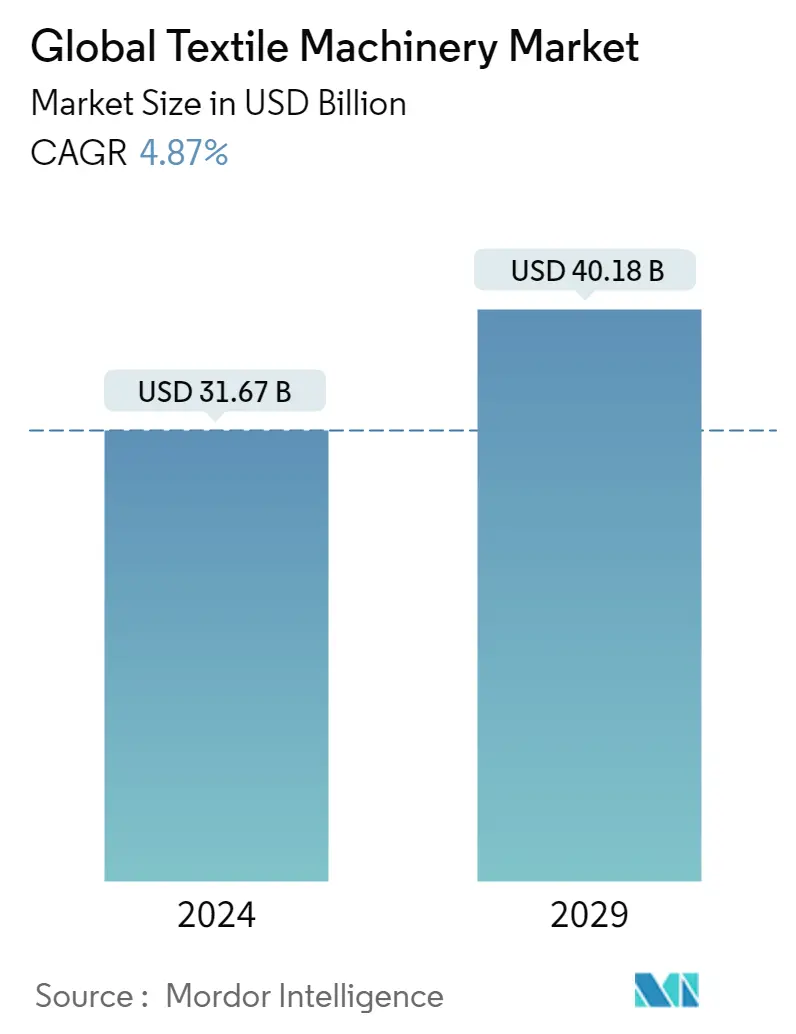
| Study Period | 2019 - 2029 |
| Market Size (2024) | USD 31.67 Billion |
| Market Size (2029) | USD 40.18 Billion |
| CAGR (2024 - 2029) | 4.87 % |
| Fastest Growing Market | Asia-Pacific |
| Largest Market | Asia-Pacific |
Major Players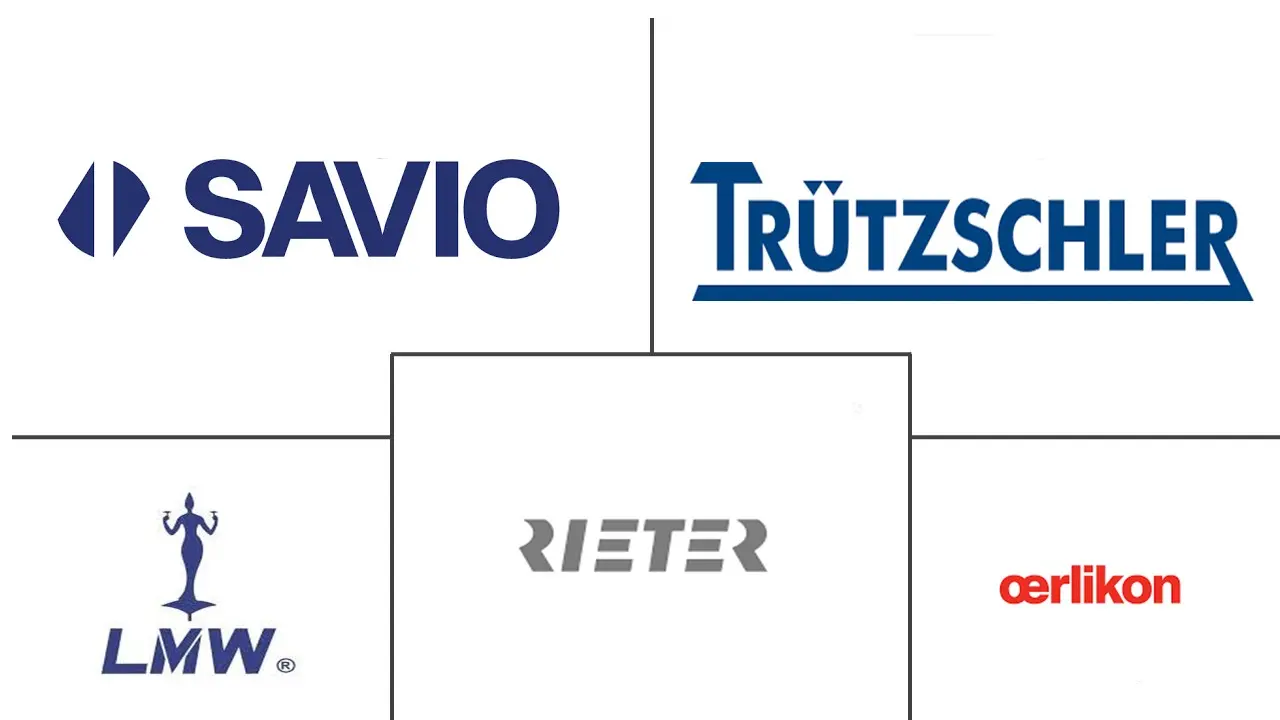
*Disclaimer: Major Players sorted in no particular order |
Textile Machinery Market Analysis
The Global Textile Machinery Market size is estimated at USD 31.67 billion in 2024, and is expected to reach USD 40.18 billion by 2029, growing at a CAGR of 4.87% during the forecast period (2024-2029).
- The increased need for sophisticated equipment that generates high-quality fabric as well as advancements in printing technology in textile production are driving market expansion. The increased use of automation and robots in textile manufacturing is also boosting the textile machinery industry.
- Machine makers now provide complex machines with increased production capacity and speed, as well as textile machinery, at cheap costs. Several small-scale market participants also help to make the machinery sector more competitive, and multinational firms have entered the global market, raising competition and forcing enterprises to improve their innovation and productivity. Because of constant technical improvements, the textile machinery industry is particularly dynamic, shifting from traditional to more complex solutions.
- While the COVID-19 situation brought problems such as shortages of raw materials, price increases, and disruptions in the supply chain, the pent-up demand during this period resulted in an increase and recovery in orders in 2021. The important and major changes created by the pandemic in daily life have also brought concepts such as sustainability, circular production, and digitalization into the focus of stakeholders investments and decisions. The world's leading textile machinery and technology manufacturers anticipate that the increasing momentum and sustainable production-oriented developments that began in 2022 will continue in 2023 and that the sector will revive with the organization of numerous international exhibitions.
Textile Machinery Market Trends
Spinning Machine Segment is the Fastest Growing Machinery Segment
The spinning machinery segment is expected to be the fastest-growing textile machinery segment over the next five years. Much of this segment's growth can be attributed to the expansion of the cotton spinning machinery. The cotton spinning machine market is likely to be driven by rising demand for textile goods and environmentally friendly fibers in emerging countries. Europe is a significant producer of textile machines.
Asia-Pacific is close to most of the countries that make clothes and textiles. This gives producers a huge chance to meet demand in the region.In order to lower operating costs, automation is in great demand in countries where production costs are high and labor is expensive. During the projected period, factors such as automation and rising demand are expected to provide a substantial potential for manufacturers to meet the need for technologically upgraded cotton spinning machines.
The Indian textile machinery industry is experiencing tremendous growth, facilitated by the country's booming textile and apparel markets. Cotton production in India is expected to reach 7.2 million metric tons (43 million bales of 170 kg each) by 2030, owing to rising consumer demand. Currently, the textile machinery industry plays an increasingly vital role in shifting India's textile and apparel industry from labor-intensive production to a more advanced and industrialized sector. With the growing demand for textile machinery in both domestic and international markets, the Indian textile machinery industry is expected to see greater development in the near future.
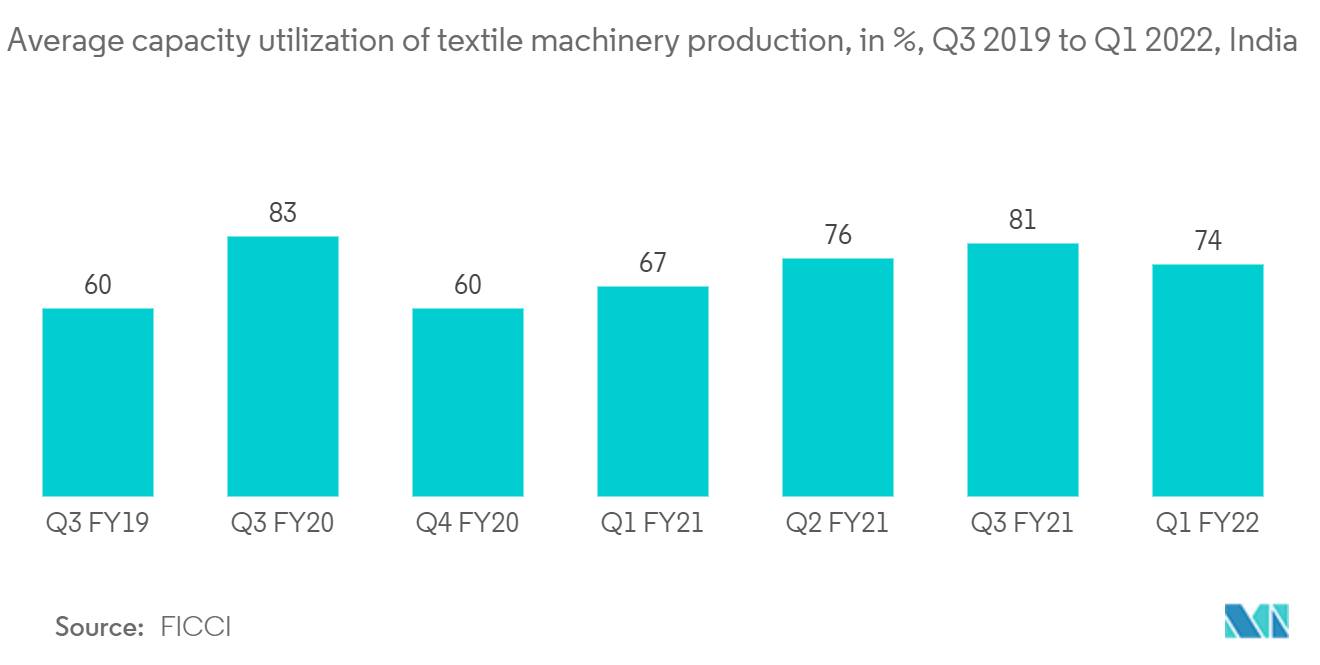
Asia-Pacific region is the Fastest Growing Region
The Asia-Pacific region is expected to dominate the global textile machinery industry. The rising involvement of foreign firms in the garment and textile sectors is an important element driving regional market expansion. Asia Pacific's major textile machine markets include India, Vietnam, China, Japan, South Korea, and Indonesia. The presence of a significant textile sector and rising garment demand are driving regional growth. Furthermore, growing investments by global firms in the textile sector in India are fueling regional growth.
From April 2016 to March 2021, Japan, Mauritius, Italy, and Belgium were the top FDI providers to India's textile sector (including dyed and printed textiles).. India achieved its highest-ever Textiles and Apparel (T&A) and Handicrafts export total of USD 44.4 billion in FY 2021-22, representing a 41% and 26% rise over equivalent amounts in FY 2020-21 and FY 2019-20, respectively. From 2017 to 2022, FDI invested USD 1522.23 million in the textile sector.
Because of schemes like the Pradhan Mantri Mega Integrated Textile Region and Apparel (PM MITRA) Parks, the Production Linked Incentive (PLI) Scheme for Textiles, and the allocation of Rs. 1480 crore (USD 180.84 million) for the National Technical Textiles Mission (NTTM), FDI may increase in the Indian textile industry in the future.
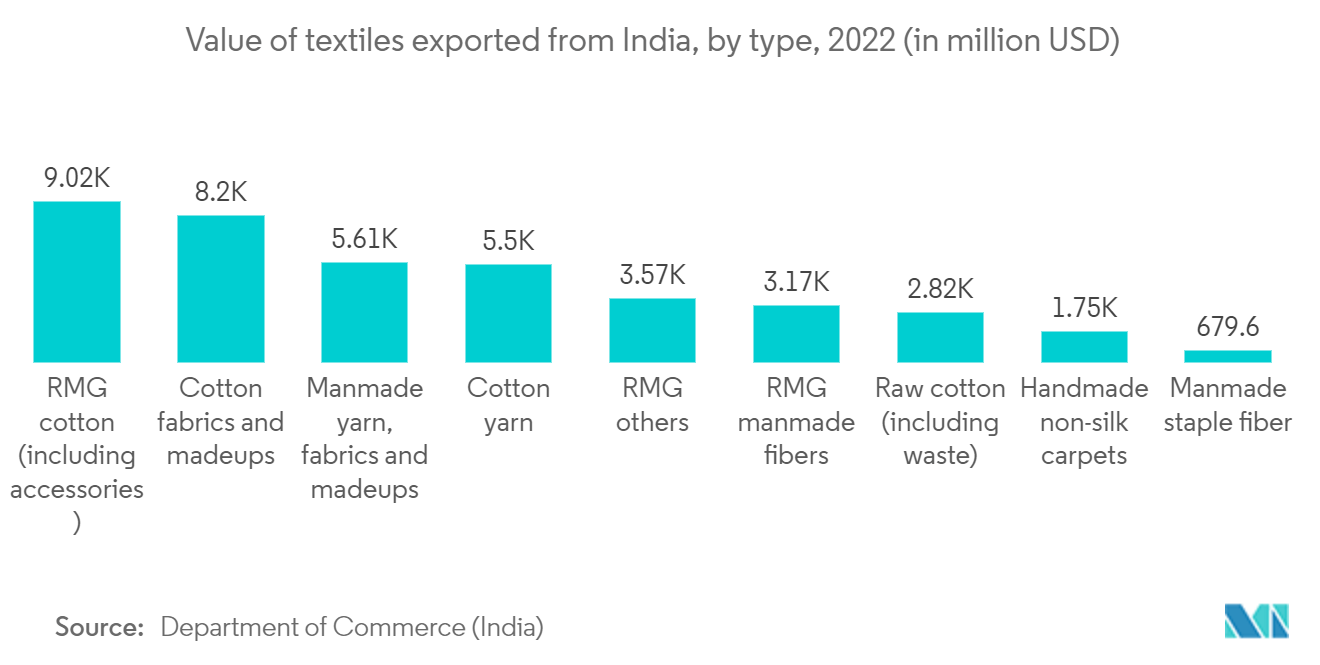
Textile Machinery Industry Overview
The companies in the global textile machinery industry don't have a lot of market share because the market is very competitive and divided.There are a lot of mergers and acquisitions going on right now because companies want to grow their geographic reach and their own knowledge. For example, in October 2021, Kornit, a company that was an early leader in digital printing machines, bought Voxel8, a company that made new textile additive manufacturing technology. The technique developed by Voxel8 enables the digital manufacture of functional features with zonal control of material characteristics as well as the use of high-performance elastomers adhering to inkjet technology.
Some of the leading players in the textile machinery market around the world are OC Oerlikon, Trützschler Group Benninger AG (Jakob Müller AG), Savio Macchine Tessili S.p.A., Camozzi Group SpA., Itema SpA., and Lakshmi Machine Works Limited, among others.
Textile Machinery Market Leaders
-
OC Oerlikon
-
Trützschler Group
-
Savio Macchine Tessili S.p.A
-
Lakshmi Machine Works
-
Rieter Holding AG
*Disclaimer: Major Players sorted in no particular order
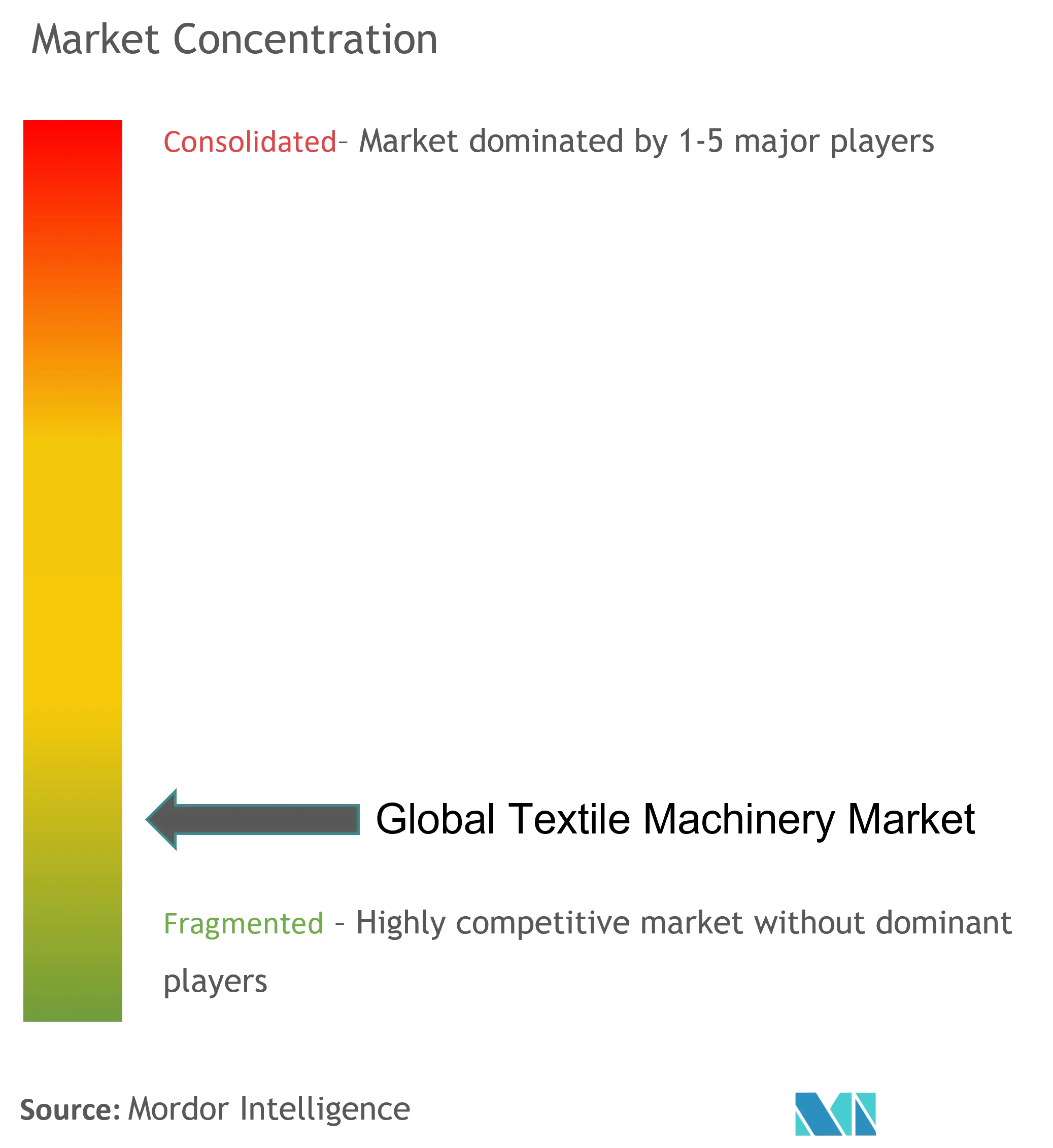
Textile Machinery Market News
June, 2022: Trützschler Nonwovens & Man-Made Fibers work with Texnology, an Italian textile machinery company, to develop full needle-punching lines. T-SUPREMA will be the brand name for the lines, which will be accessible immediately. Web bonding using steel needles is the most important manufacturing method in the dry-laid nonwoven industry. The majority of uses are of a technical nature, with the most significant being durable geotextiles, automotive textiles, and filter media.
January, 2022: PLY1, the single ply cutting system from Morgan Tecnica, Italy (from ATE Group), is designed to meet the demands of the industry. The PLY1 features multiple cutting heads that can cut both soft as well as hard textile materials. PLY1 can handle all types of textiles, including carpet fabric and even special materials of different compositions and dimensions, including thicknessessingle-plymm - with great precision and high speed.
April, 2021: Ingersoll Machine Tools broke ground on a 40,000-square-foot expansion to build the Giant Magellan Telescope structure. The expansion comprises the installation in the new building of an Ingersoll MasterMillTM that will constitute one of the largest milling centers in the United States, also serving the manufacturing needs of the U.S. Defense Department.
Textile Machinery Market Report - Table of Contents
1. INTRODUCTION
- 1.1 Study Deliverables
- 1.2 Study Assumptions
- 1.3 Scope of the Study
2. RESEARCH METHODOLOGY
3. EXECUTIVE SUMMARY
4. MARKET INSIGHTS AND DYNAMICS
- 4.1 Market Overview
- 4.2 Market Drivers
- 4.3 Market Restraints
- 4.4 Market Opportunities
- 4.5 Value Chain / Supply Chain Analysis
-
4.6 Industry Attractiveness - Porter's Five Forces Analysis
- 4.6.1 Bargaining Power of Buyers/Consumers
- 4.6.2 Bargaining Power of Suppliers
- 4.6.3 Threat of New Entrants
- 4.6.4 Threat of Substitute Products
- 4.6.5 Intensity of Competitive Rivalry
- 4.7 Government Regulations and Initiatives
- 4.8 Technological Trends
- 4.9 Impact of COVID-19 on the Market
5. MARKET SEGMENTATION
-
5.1 By Raw Material
- 5.1.1 Cotton
- 5.1.2 Wool
- 5.1.3 Nylon
- 5.1.4 Polyester
- 5.1.5 Acrylic
- 5.1.6 Silk
- 5.1.7 Other Raw Materials
-
5.2 By Machine Type
- 5.2.1 Spinning Machines
- 5.2.2 Weaving Machines
- 5.2.3 Knitting Machines
- 5.2.4 Texturing Machines
- 5.2.5 Other Machine Types
-
5.3 By Distribution Channel
- 5.3.1 Direct
- 5.3.2 Indirect
-
5.4 By Application
- 5.4.1 Garments & Apparels
- 5.4.2 Household and Home Textiles
- 5.4.3 Technical Textiles (Medical, Protective, Sports, etc.)
-
5.5 By Geography
- 5.5.1 North America
- 5.5.1.1 United States
- 5.5.1.2 Canada
- 5.5.1.3 Mexico
- 5.5.2 Europe
- 5.5.2.1 Germany
- 5.5.2.2 France
- 5.5.2.3 United Kingdom
- 5.5.2.4 Italy
- 5.5.2.5 Spain
- 5.5.2.6 Russia
- 5.5.2.7 Rest of Europe
- 5.5.3 Asia-Pacific
- 5.5.3.1 China
- 5.5.3.2 Japan
- 5.5.3.3 India
- 5.5.3.4 Bangladesh
- 5.5.3.5 Turkey
- 5.5.3.6 South Korea
- 5.5.3.7 Australia
- 5.5.3.8 Indonesia
- 5.5.3.9 Rest of Asia-Pacific
- 5.5.4 Middle East & Africa
- 5.5.4.1 Egypt
- 5.5.4.2 South Africa
- 5.5.4.3 Saudi Arabia
- 5.5.4.4 Rest of Middle East & Africa
- 5.5.5 South America
- 5.5.5.1 Brazil
- 5.5.5.2 Argentina
- 5.5.5.3 Rest of South America
6. COMPETITIVE LANDSCAPE
- 6.1 Market Concentration Overview
-
6.2 Company Profiles
- 6.2.1 OC Oerlikon
- 6.2.2 Trutzschler Group
- 6.2.3 Savio Macchine Tessili S.p.A
- 6.2.4 Rieter Holding AG
- 6.2.5 Lakshmi Machine Works Ltd
- 6.2.6 Murata Machinery Ltd.
- 6.2.7 Santoni S.p.A.
- 6.2.8 Saurer Intelligent Technlogy AG
- 6.2.9 TMT Machinery Inc.
- 6.2.10 Mayer & Cie. GmbH & Co. KG*
- *List Not Exhaustive
- 6.3 Other Companies (Overview/Key Information)
7. MARKET OPPORTUNITIES AND FUTURE TRENDS
8. APPENDIX
** Subject To AvailablityTextile Machinery Industry Segmentation
Textile machines are used to make and process fabrics, clothing, and other materials. These tools are used for weaving, spinning, and dying. Textile machinery is also used to make yarn, fiber, and thread colors and finishes. Nonwovens, synthetic fibers, and a variety of polymers are also extruded with it. The textile manufacturing process includes fiber processing, yarn production, fabric production, fiber pre-treatment, dyeing and printing, and, lastly, applying finishing treatments.
The global textile machinery market is segmented by raw material (cotton, wool, nylon, polyester, acrylic, silk, and others), machine type (spinning machines, weaving machines, knitting machines, texturing machines, and others), distribution channel (direct and indirect), application (garments and apparel, household and home textiles, and technical textiles (medical, protective, sports, etc.), and geography (North America, Asia-Pacific, Europe, the Middle East and Africa, and South America). The report offers market size and forecasts for the global textile machinery market in terms of dollar value (USD billion) for all the above segments.
| By Raw Material | Cotton | |
| Wool | ||
| Nylon | ||
| Polyester | ||
| Acrylic | ||
| Silk | ||
| Other Raw Materials | ||
| By Machine Type | Spinning Machines | |
| Weaving Machines | ||
| Knitting Machines | ||
| Texturing Machines | ||
| Other Machine Types | ||
| By Distribution Channel | Direct | |
| Indirect | ||
| By Application | Garments & Apparels | |
| Household and Home Textiles | ||
| Technical Textiles (Medical, Protective, Sports, etc.) | ||
| By Geography | North America | United States |
| Canada | ||
| Mexico | ||
| By Geography | Europe | Germany |
| France | ||
| United Kingdom | ||
| Italy | ||
| Spain | ||
| Russia | ||
| Rest of Europe | ||
| By Geography | Asia-Pacific | China |
| Japan | ||
| India | ||
| Bangladesh | ||
| Turkey | ||
| South Korea | ||
| Australia | ||
| Indonesia | ||
| Rest of Asia-Pacific | ||
| By Geography | Middle East & Africa | Egypt |
| South Africa | ||
| Saudi Arabia | ||
| Rest of Middle East & Africa | ||
| By Geography | South America | Brazil |
| Argentina | ||
| Rest of South America |
Textile Machinery Market Research FAQs
How big is the Global Textile Machinery Market?
The Global Textile Machinery Market size is expected to reach USD 31.67 billion in 2024 and grow at a CAGR of 4.87% to reach USD 40.18 billion by 2029.
What is the current Global Textile Machinery Market size?
In 2024, the Global Textile Machinery Market size is expected to reach USD 31.67 billion.
Who are the key players in Global Textile Machinery Market?
OC Oerlikon, Trützschler Group, Savio Macchine Tessili S.p.A, Lakshmi Machine Works and Rieter Holding AG are the major companies operating in the Global Textile Machinery Market.
Which is the fastest growing region in Global Textile Machinery Market?
Asia-Pacific is estimated to grow at the highest CAGR over the forecast period (2024-2029).
Which region has the biggest share in Global Textile Machinery Market?
In 2024, the Asia-Pacific accounts for the largest market share in Global Textile Machinery Market.
What years does this Global Textile Machinery Market cover, and what was the market size in 2023?
In 2023, the Global Textile Machinery Market size was estimated at USD 30.20 billion. The report covers the Global Textile Machinery Market historical market size for years: 2019, 2020, 2021, 2022 and 2023. The report also forecasts the Global Textile Machinery Market size for years: 2024, 2025, 2026, 2027, 2028 and 2029.
Global Textile Machinery Industry Report
Statistics for the 2024 Global Textile Machinery market share, size and revenue growth rate, created by Mordor Intelligence™ Industry Reports. Global Textile Machinery analysis includes a market forecast outlook to 2029 and historical overview. Get a sample of this industry analysis as a free report PDF download.



